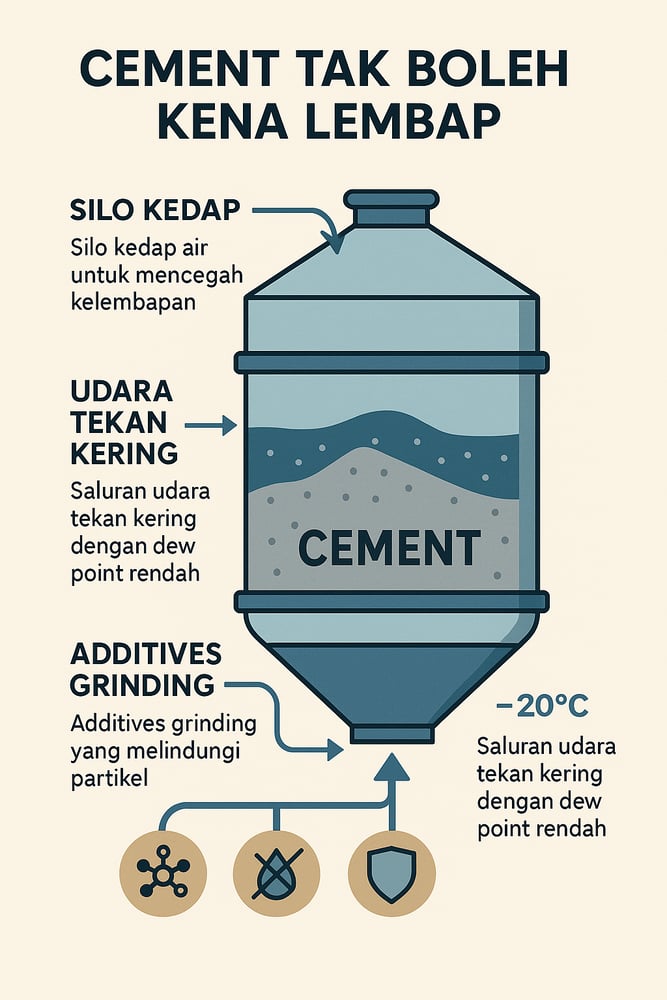Cement is so hygroscopic that brief humidity spikes can ruin weeks of production. Plants are fighting back with watertight silos, ultra‑dry pneumatic air, and chemistry at the grinding stage—each with data to prove it.
Industry: Cement | Process: Cement_Storage_&_Packaging
Cement’s worst enemy isn’t wear on the kiln or a finicky mill—it’s moisture. Industry specialists warn that “no matter the design…silos are susceptible to flow issues” when water vapor gets in, leading to clumping, bridging, and even structural overload as material hardens and expands inside the vessel (www.usasilos.com).
The tolerance band is tight. One concrete reference notes cement stored above 80% RH (relative humidity, the percentage of water vapor in air versus its saturation point) can spoil in weeks, while a cool, dry ~50% RH is considered ideal (concretecaptain.com). Plants that keep storage areas below 50%–60% RH report fewer quality hits; brief excursions above ~80% RH can drastically reduce shelf-life and yield (PCA data) (concretecaptain.com).
The fixes are not glamorous, but they are decisive: seal everything, dry the conveying air, and tweak the powder’s surface chemistry so it resists humidity. The combination is increasingly standard practice—and supported by field cases and product data.
Humidity thresholds and shelf‑life risk
Even small leaks or ambient moisture can cause cement to “solidify within the silo,” expand, block discharge, and overload silo walls (www.usasilos.com). The practical implication: storage must be completely watertight, and the air around the material kept dry enough that the powder never reaches a condensation point.
Plants that target ~50% RH in warehouses deploy preventive basics—coated silo roofs, upright silo pads to shed water, plastic linings, and raised pallets—plus routine dehumidification (desiccant units or dehumidifiers) (www.usasilos.com; concretecaptain.com). When aerating silo contents, an air dryer is essential; excessive aeration can pump humid air into the cement and trigger unwanted hydration (www.usasilos.com).
Silo sealing and vent filtration
Effective design and maintenance turn a silo into a moisture barrier. Experts emphasize the structure must be “completely watertight,” with sealed seams, dual‑seal manways, coated roofs, and vents fitted with filters that block humid air (www.usasilos.com). Many installations use pressure‑relief vents with reverse‑jet bag filters—allowing gas to escape while keeping dust, and thus moisture pathways, out—plus pneumatic or diaphragm vents with desiccant cartridges (www.usasilos.com).
Operations matter, too. Silos “regularly emptied and refilled” see fewer flow blockages than vessels left constantly full; routine inspection of roof seals and external waterproof coatings, and replacing worn air pads or aeration stones, prevents moisture ingress and dead zones (www.usasilos.com). Plants are also monitoring the silo atmosphere with dew‑point and humidity sensors (dew point is the temperature where water vapor condenses), and diverting ventilation when ambient air turns humid (www.usasilos.com; concretecaptain.com).
Compressed air quality for pneumatic conveying

In plants that move powder pneumatically, the moisture carried in compressed air can be the last uncontrolled water source. A coastal Ghana facility reported that even small amounts of moisture in the conveying air created “clumps in the cement and the additives,” plus deposits and equipment corrosion; installing refrigeration dryers to deliver a 2 °C dew point to each mill’s air supply resolved the clumping (www.beko-technologies.com).
Specifications often target ISA air quality Class 2–3 (industry classification for compressed air) for cement conveying; one reference cites ISO 8573 Class 3—roughly a −20 °C dew point and oil below 1 mg/m³—for powdered materials (www.bulk-online.com). In practice, plants dry and filter air with refrigeration or desiccant dryers plus coalescing filters before it reaches silos or trucks (www.bulk-online.com).
Pressure control is part of the quality equation. Cement conveying typically runs below 4 bar, so dedicated low‑pressure blowers or Roots compressors are sized to minimize pressure drop and turbulence; oversizing a high‑pressure compressor and throttling it wastes energy and can encourage condensate formation (www.atlascopco.com; www.atlascopco.com). Industry sources therefore advise dedicated low‑pressure blowers and high‑capacity air dryers that keep dew points near ambient or lower (www.beko-technologies.com; www.bulk-online.com).
Grinding‑stage additives and flow behavior
Plants are also shifting the powder’s surface chemistry during milling. Grinding aids—such as amines or polycarboxylate‑based (PCE) dispersants—are interground to raise throughput and fineness and to improve powder flow. A SikaGrind®‑870 example shows how these additives “dramatically improve powder flow behavior” in finished cement (pak.sika.com; zaf.sika.com). In a lab test, a 0.03% PCE‑based addition lifted the ring‑shear flow coefficient (FFC, a measure of how freely a powder flows) from 2.00 to 2.30—about a 15% gain—and reduced the pack‑set index from 9 to 4 (zaf.sika.com).
These agents can impart minor air‑entrainment and longer working time, slightly damping early hydration if trace moisture is present. Dosing must be tailored to avoid overly “slick” handling. Many producers meter liquids with accurate pumps; for example, a mill‑line install can use a dosing pump for consistent additive feed.
Hydrophobic treatments for moisture resistance
For explicit repellency, hydrophobic additives—emulsions of fatty acids, waxes, and polymers—are co‑ground to entrap air and create water‑repellent particle surfaces. GCP’s Hydrophobe® series is positioned to reduce cement’s hygroscopic tendency and improve handling; manufacturers report masonry cements treated this way better resist moisture contact (gcpat.com). Even thin aliphatic coatings can raise the water contact angle, slowing initial absorption.
In practice, adding 0.5%–1.0% by weight of a hydrophobic grinding additive can extend shelf‑life by months under marginally humid conditions; one patent on hydrophobic cement cites up to a 4‑fold reduction in water absorption with specialized blends of salts and siloxanes (gcpat.com).
Integrated moisture‑control playbook
The industry’s “battleship” is three‑pronged and data‑backed: rigorously sealed silos and warehouses (often climate‑controlled near ~50% RH), ultra‑dry compressed‑air systems for pneumatic conveying (dew points as low as 2 °C in case studies), and targeted mineral or polymer additives at the mill to improve flow and coat cement grains (www.usasilos.com; concretecaptain.com; www.beko-technologies.com; www.bulk-online.com; pak.sika.com; zaf.sika.com; gcpat.com).
The throughline across sources is consistent: keep RH below 50%–60% in storage, make the silo airtight and filtered, dry the conveying air to ISO 8573 Class 3 or better when specified, and use grinding‑stage additives that measurably raise flowability while reducing hygroscopic behavior (www.usasilos.com; concretecaptain.com; www.bulk-online.com).
